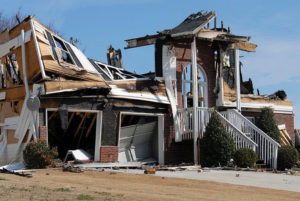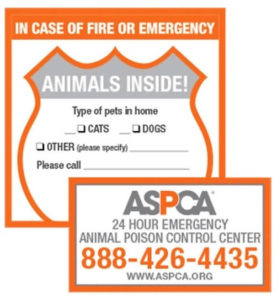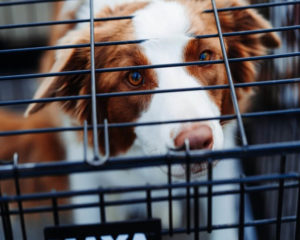How to Keep Your Pet from Burning Down the House and Safe in Case of a Fire

July 15th is National Pet Fire Safety Day, but we think any day is a good day to help keep your home and pets safe from fires. Did you know that the American Red Cross responds to more home fires than any other disaster? And it’s the most preventable! This blog provides tips on how you can be prepared to help prevent your pet from starting fires, and how to keep them safe in case of a fire.

House fires are the most preventable disasters, but they are also the number one disaster that the American Red Cross responds to.
How do pets start fires?
Nearly 1,000 fires are started each year by pets, according to The National Fire Protection Association. We aren’t suggesting that arsonist pets are running around deliberating about setting fires! But our companions are capable of accidentally setting fires by many different means. We spoke to one St. Pete firefighter that said he’s discovered fires started by pets that chewed through electrical cords and that knocked over space heaters in the winter.
Stoves, Heaters, and Electrical Cords
While you probably don’t own an “arson” pet, accidents do happen. Chewing electrical cords, knocking over space heaters, turning on the stove, and getting too close to open flames are the top ways pets can set off a chain reaction that ultimately results in a house fire.
Stoves with knobs on the front are the number one cause of pet-started fires, as pets can turn these knobs on. Cats use them as stepping stones, and larger dogs can jump up and knock them with their front paws. It’s imperative that pet owners pet-proof their homes. If your stove has front knobs, consider removing them if possible when the stove is not in use or installing child-proof covers to protect the knobs from misadventures.

Stoves with knobs on the front, like the one shown here, are the number one cause of pet-started fires. Consider removing front knobs when not in use, or installing child proof covers over them.
Our friendly neighborhood fireman also told us that, unfortunately, pets have been known to die when chewing through electrical cords. So make sure to keep cords out of reach, or utilize cord covers to keep them inaccessible.
Candles, Flames, and Glass Water Bowls
The saying “curiosity killed the cat” was coined for a reason. Flickering flames have been known to draw cats to them like moths to…well…a flame. Make sure candles and any flames or embers in a fireplace are fully extinguished before you leave your home—or even if you’re leaving the room for more than a few minutes—to keep inquisitive kitties from getting too close to investigate.

Flickering flames have been known to draw cats over to investigate. Make sure candles and any flames in a fireplace are extinguished. Battery operated flameless candles are an excellent alternative to candles.
Never leave an open flame unattended. Candles can easily be knocked over by both dogs and cats. Battery-operated flameless candles are an excellent alternative to the real thing if you want to enjoy the ambiance of candles without it posing the danger of starting a fire.
You may have never considered another potential fire starter: clear glass water bowls left outside on wooden decks or porches. The bowl acts much like a magnifying glass directing the sun’s rays to the wood below and can ignite a fire.

Never leave clear glass water bowls outside on wooden decks. The bowl acts much like a magnifying glass directing the sun’s rays to the wood below, igniting a fire.
What can I do to make sure my pet and home are safe?
Smoke Detectors and Fire Extinguishers
Ensure your smoke detectors have working batteries. You might also consider monitored smoke detectors; that way, firefighters can be called to your house even if you aren’t home. Also, be prepared in case a fire does break out in your home. Keeping a fire extinguisher in the kitchen, as well as on each floor of the home, is ideal.
Pet Alert Stickers and Crates Near Entrances
In speaking with our SPFD firefighter, we asked if those stickers you sometimes see affixed to windows that alert firemen to the number of pets in the home work. He said they do. When the firefighting crew arrives on the scene, they look for those stickers, especially when the owners are not home. So be sure to keep your pet-alert stickers up-to-date, so that our firefighters don’t waste precious time—and their lives—looking for a pet that is not actually in the house anymore.
However, our fireman said the most important thing you can do to help them out if you are home when a fire occurs, is to NOT go back into a burning building to look for your pet. Let them do that. Let them know how many pets are inside and where they typically like to hide.

Pet safety stickers work. When the fight fighting crew arrives on the scene, they actually look for these stickers. But the most important thing you can do to help out fire fighters is to NOT go back in the building to look for your pet.
If your pet gets confined to a crate when you leave the house and at night, consider keeping them near the entrances of the home so that you can easily locate and evacuate them with you in case of a fire, or so that firefighters can easily get to them. If you have a sticker up, and you have gotten your pets out of the home, be sure to let the rescue workers know. You can get a rescue alert sticker from many local pet stores, or for free from the ASPCA.

If you crate your pet when you are away or asleep, consider keeping them near an entrance to your home so that you or the fire department can easily locate and evacuate them with you in case of a fire.
Fire Escape Plans and Pet Identification
Include your pets in your escape plan and fire drills, and train your pets to come when you call. Practicing your escape route with your pets will help them to know what to do in case of an emergency.
It’s a good idea to keep collars, identification (if your pet doesn’t already wear them at all times), and leashes near the door. Also handy is a “go bag” that includes food, water, medications, a change of clothes for everyone in the family, a first aid kit, and copies of important documents in case you lose everything in a fire. And in case a pet goes missing during the evacuation, be sure to have a recent photo of your pet.
It’s also a good idea to plan and make a digital “lost pet” flyer that can quickly be shared on social media in case your pet runs away in the stress and confusion of an emergency. Consider microchipping your pet if you haven’t already. Collars and tags can be lost or removed, but a microchip is a permanent way to have identification on your pet.

If your pet doesn’t already wear identification at all times, keep collars with id tags and leashes near the door. Consider microchipping your pet if you haven’t already.
Conclusion
In review, to help prevent your pet from starting a fire:
- Keep electrical cords safely out of pets’ reach and install cord covers for cords that must remain out.
- When using a space heater, make sure it has a safety feature that will turn itself off if it gets knocked over. Make sure you never leave pets unattended with running space heaters.
- Remove knobs located on the front of stoves, or install child-proof covers.
- Never left a pet unattended in a room with candles or any other type of open flame.
- Don’t leave glass water bowls on wooden decks. The sun’s rays have been known to ignite fires.
To help your pet get rescued in case of a fire:
- Consider monitored smoke detectors and keep fire extinguishers near at hand.
- Affix fire alert rescue stickers near the entrances of your home. Keep the information current and alert fire rescuers if you’ve evacuated your pet with you.
- Keep your dog confined in a crate near the entrance of the home, or know where their favorite hiding places are so that you can tell fire rescue.
To help locate your pet after a fire:
- Keep it on your pet.
- Consider microchipping your pet if they aren’t already.
- Keep a current photo of your pet in a go-bag or on your phone.
- Prepare ahead of time and make a digital “lost pet” flyer you can quickly post to social media.
We hope that these tips will help you to plan for the emergency of a house fire and help keep your pet safe. July 15th may be Pet Fire Safety Day, but every day is a great day to be prepared!
Northeast Animal Hospital and Downtown St. Pete Vet Clinic are sister practices located in sunny St. Petersburg, Florida. We are devoted to helping pet owners connect with their pets while educating them on topics that will help keep their pets happy and healthy. If you are local to St. Pete and its surrounding areas and have any questions, please don’t hesitate to contact us. If you’ve found us through a web search, we hope we’ve helped answer your question on this subject. If you reside beyond the Tampa Bay area we recommend you contact your local veterinarian for any further needed assistance.
